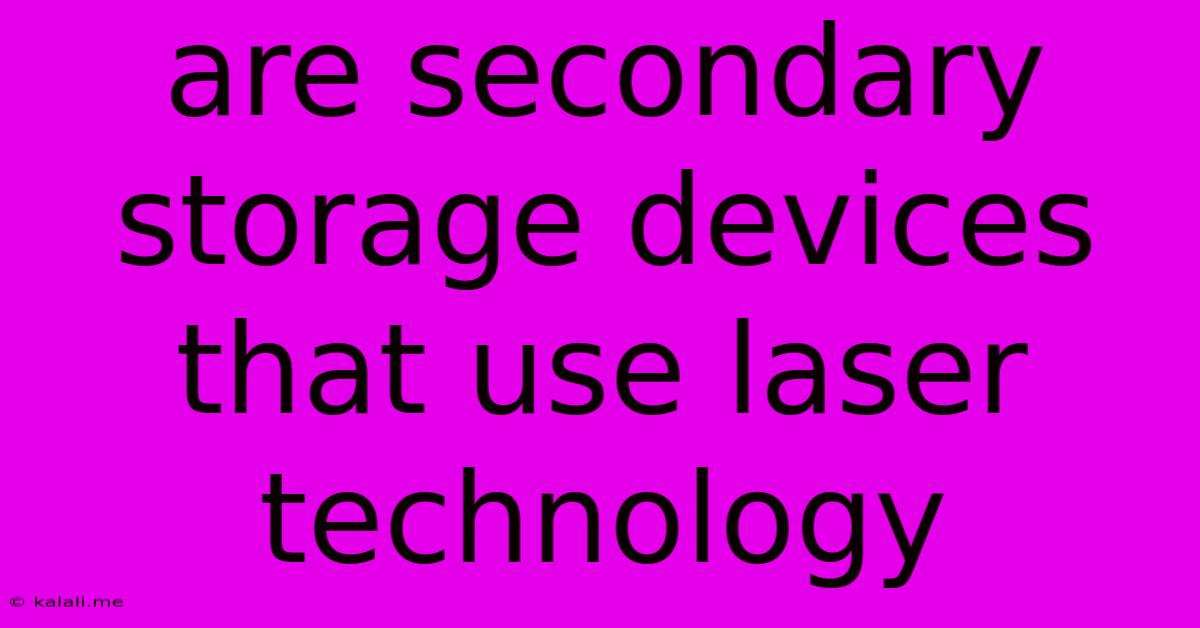Are Secondary Storage Devices That Use Laser Technology
Kalali
Jun 16, 2025 · 3 min read

Table of Contents
Are Secondary Storage Devices That Use Laser Technology? Yes, and Here's How They Work
Optical storage devices are secondary storage devices that use laser technology to read and write data onto a physical medium. This technology allows for relatively inexpensive, portable, and durable storage solutions, though they're often less capacious than other secondary storage options like hard disk drives (HDDs) or solid-state drives (SSDs). This article will explore the different types of optical storage devices and how they utilize laser technology for data storage and retrieval.
Understanding the Basics of Optical Storage
Optical storage relies on the principle of reflecting laser light off a surface to read data. The data is encoded as pits and lands on a disc's surface. Pits are microscopic indentations, while lands are the flat areas between them. A laser beam shines onto the disc's surface, and the variations in light reflection caused by the pits and lands are interpreted as binary data (0s and 1s).
The process involves a laser diode that emits a highly focused beam of light. This beam interacts with the reflective layer of the disc, and the resulting changes in light intensity are detected by a photodiode. This detection process translates the light reflections into electrical signals, which are then processed by the computer to retrieve the stored data.
Types of Optical Storage Devices
Several types of optical storage devices exist, each with varying storage capacities and data transfer speeds:
-
CD-ROM (Compact Disc Read-Only Memory): These are the earliest and most basic form of optical storage. They are read-only, meaning data cannot be written or erased. They use a low-power laser to read the data encoded on the disc.
-
CD-R (Compact Disc Recordable): CD-Rs allow users to write data once onto the disc. A higher-powered laser is used to create the pits on the disc's surface. Once written, the data is permanent.
-
CD-RW (Compact Disc Rewritable): CD-RWs are similar to CD-Rs but allow for multiple write and erase cycles. A phase-change material is used to alter the reflectivity of the surface, enabling rewriting.
-
DVD (Digital Versatile Disc): DVDs offer significantly higher storage capacity than CDs due to a shorter wavelength laser, allowing for more data to be stored in the same physical space. They come in various formats, including DVD-ROM, DVD-R, DVD-RW, DVD+R, and DVD+RW. The "+" and "-" variations represent different manufacturing standards.
-
Blu-ray Disc: Blu-ray discs use a blue-violet laser with an even shorter wavelength than DVDs, resulting in even higher storage capacities. They are commonly used for high-definition video storage and are also available in recordable and rewritable formats.
-
HD DVD: While initially competing with Blu-ray, HD DVD technology ultimately failed to gain widespread adoption.
Advantages and Disadvantages of Optical Storage
Advantages:
- Portability: Optical discs are lightweight and easily transportable.
- Durability: When handled correctly, they offer reasonable resistance to physical damage.
- Cost-effectiveness: Optical media is relatively inexpensive compared to other storage options.
- Readability: Optical discs can be read across a wide range of devices.
Disadvantages:
- Limited storage capacity: Compared to HDDs and SSDs, optical discs have significantly less storage capacity.
- Susceptibility to scratches and damage: Scratches can easily impair readability.
- Slow data transfer speeds: Compared to HDDs and SSDs, data transfer speeds are relatively slow.
- Data degradation: Over time, data on optical discs can degrade, especially if exposed to extreme temperatures or humidity.
The Future of Optical Storage
While the dominance of optical storage has declined due to the rise of HDDs and SSDs, it continues to find niche applications, especially where portability and cost-effectiveness are paramount. Technological advancements might see improvements in capacity and speed, although these improvements are unlikely to match the pace of other storage technologies.
In conclusion, optical storage devices are indeed secondary storage devices that leverage laser technology for efficient data storage and retrieval. Understanding their functionality, advantages, and disadvantages helps in making informed choices regarding data storage needs.
Latest Posts
Latest Posts
-
How To Create Clickable Image In Html
Jun 16, 2025
-
What Are The Factors Of 121
Jun 16, 2025
-
What Is A Theme Of The Passage
Jun 16, 2025
-
A Company That Provides Access To The Internet
Jun 16, 2025
-
Which Word Is Closest In Meaning To The Underlined Word
Jun 16, 2025
Related Post
Thank you for visiting our website which covers about Are Secondary Storage Devices That Use Laser Technology . We hope the information provided has been useful to you. Feel free to contact us if you have any questions or need further assistance. See you next time and don't miss to bookmark.